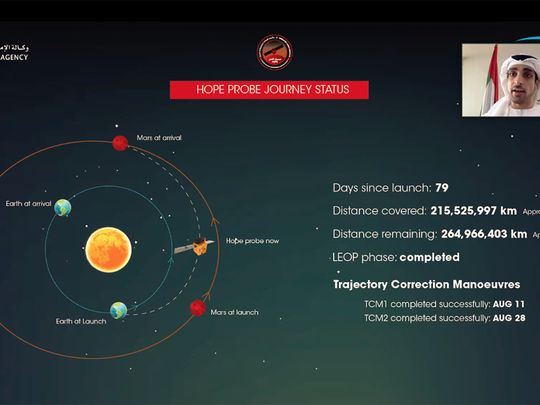Dubai: The UAE’s Hope Probe, the first Arab interplanetary mission to Mars, is almost halfway to its orbital mission 79 days after it was successfully launched from Japan, lead scientists and engineers at Mohammed bin Rashid Space Centre (MBRSC) announced in Dubai during a Press briefing on Wednesday.
Launched from Tanegashima Space Center in the early hours of July 20, Hope Probe, which is set to reach Mars in February next year, has so far travelled 215.5 million kms. It is currently cruising at an average speed of 103,379km/hr and still has to cover 264.9 million kms out of the total 480 million kms journey to the Red Planet for seven months.
The Emirates Mars Mission (EMM) has also recently launched a website (emiratesmarsmission.ae/track-the-hope-probe-live/) for live tracking of Hope Probe.
Cruising to Mars
Omran Sharaf, project manager of the EMM, said all the early operations have concluded and Hope Probe is now on its cruising phase as contact with the orbiter has downgraded to two to three times a week to conduct regular checking and spacecraft commissioning.
The ground control at MBRSC has also successfully conducted two trajectory correction manoeuvres (TCM) last August 11 and 28. Sharaf noted the third TCM, scheduled later this month or early November, would be critical as Hope Probe reaches its halfway mark. He added the orbiter requires at least six to seven TCMs to ensure it is on the correct trajectory or path to Mars.
Managing the risks
Sharaf pointed out risk is always part of Hope Probe journey — from preparation to launch to travel in deep space. “But what is important is that we manage the risks and don’t let them become anomalies. Hope Probe is travelling in deep space and we still need to understand how its environment is affecting it. That is why tests are regularly conducted to see any changes. We manage the risks and don’t let them turn into anomalies,” Sharaf underscored.
Suhail Al Dhafri, EMM deputy project manager and spacecraft lead, assured Hope Probe is “showing excellent performance as it cruises towards Mars.”
AlDhafri noted all commissioning tests on different sub systems, including power, communication and control systems of the spacecraft have been tested and all instruments, were protected in space, particularly from solar flare.
Mars orbit insertion
EMM engineers also assured Hope Probe is on course for its Mars orbit insertion (MOI), despite few days delay during the launch. They explained Hope Probe took off within the narrow launch window. MOI will be the most challenging part of the mission. Sharaf explained accuracy is the key to success. “If Hope Probe goes too fast or too slow, it will crash on Mars or miss its orbit entirely. As it approaches Mars’ orbit, Hope Probe will do a 30-minute fuel burn using its thrusters and reduce its speed from 121,000kph to 18,000kph,” he added.
Science phase
After entering Mars’ orbit, Hope Probe will then transition to science phase. This is when it will commence with its mission to build the first complete structure of the Martian atmosphere using its three advanced scientific instruments that will pictures for one Martian year or around two Earth years.

